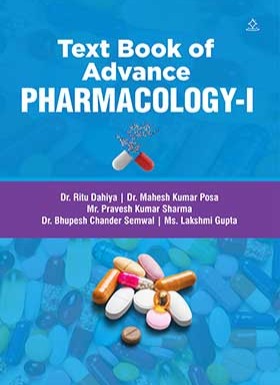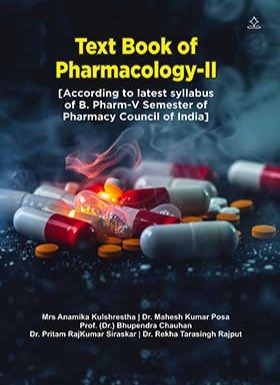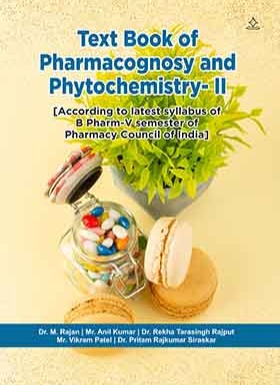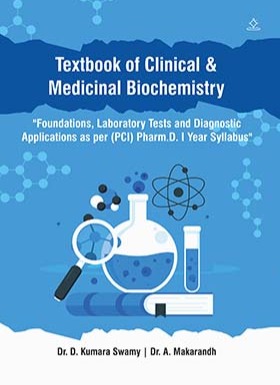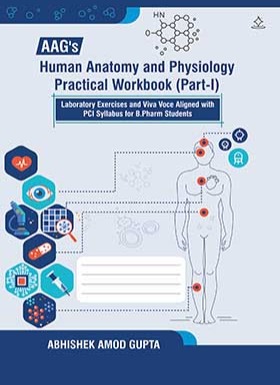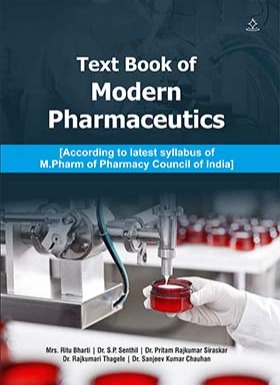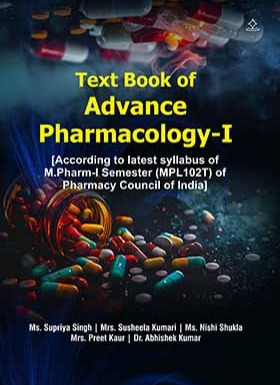About Book
The Textbook of Advanced Pharmacology-I is a comprehensive guide that delves into the principles, mechanisms, and clinical implications of pharmacology at an advanced level. It begins with pharmacokinetics, explaining drug absorption, distribution, metabolism, and elimination, and highlighting both linear and non-linear compartment models. The role and significance of protein binding are thoroughly discussed to help understand drug disposition and efficacy. The next section, pharmacodynamics, explores mechanisms of drug action, concentration–effect relationships, receptor theory, and quantification of drug–receptor interactions, offering clarity on structural and functional receptor families. The book then examines neurotransmission, covering general processes and steps in chemical signaling. It explains autonomic neurotransmission in depth, particularly adrenaline and acetylcholine, and then expands to central neurotransmitters including histamine, serotonin, dopamine, GABA, glutamate, and glycine. Special attention is also given to non-adrenergic non-cholinergic (NANC) transmission and the concept of co-transmission. The systemic pharmacology section emphasizes parasympathomimetics, parasympatholytics, sympathomimetics, sympatholytics, and neuromuscular junction agents, linking their actions to therapeutic and toxicological effects. Moving to the central nervous system pharmacology, the book addresses general and local anesthetics, sedatives, hypnotics, anxiolytics, antidepressants, antipsychotics, mood stabilizers, antiepileptics, neurodegenerative disease treatments, narcotic and non-narcotic analgesics, with detailed mechanisms and clinical applications. The cardiovascular pharmacology portion covers diuretics, antihypertensives, anti-ischemic agents, anti-arrhythmics, heart failure therapies, lipid-lowering drugs, hematinics, coagulants, anticoagulants, fibrinolytics, and anti-platelet drugs, with emphasis on disease pathophysiology and novel therapies. Additionally, the book devotes a section to autocoid pharmacology, elaborating on the physiological and pathological roles of histamine, serotonin, kinins, prostaglandins, and opioid autocoids, as well as pharmacological aspects of 5-HT agonists and antagonists. Throughout, the text maintains a balance between fundamental concepts, experimental pharmacology, and clinical applications, ensuring readers grasp both theory and practice. It highlights both established agents and novel drug classes, making it useful for postgraduates, researchers, and healthcare professionals. The organization of content ensures progressive learning—starting from basic pharmacokinetics to complex system-based pharmacology. The textbook also stresses toxicological considerations and safety profiles, which are critical in modern therapeutics.
This book is not only a reference for exams but also a resource for clinical decision-making and drug development. Its inclusion of receptor pharmacology and neurotransmitter mechanisms provides a foundation for future research in neuropharmacology. By integrating pathophysiology with pharmacology, it helps readers appreciate the rationale behind drug therapy. The emphasis on novel agents reflects the evolving nature of medicine and personalized therapy. Each section presents detailed yet accessible explanations, encouraging deeper understanding of drug action. It also bridges the gap between molecular mechanisms and therapeutic outcomes.
About Author
Dr. Ritu Dahiya is an Associate Professor at Lingaya’s Vidyapeeth, Faridabad, with over 11 years of teaching and research experience in pharmacology. She holds a B.Pharmacy and M.Pharmacy (Pharmacology) from Maharishi Dayanand University and has submitted her Ph.D. thesis at Delhi Institute of Pharmaceutical Sciences and Research University, New Delhi.Her research expertise spans diabetes and its complications, ocular drug delivery, infectious diseases, and oncology, with a particular focus on cancer biology, molecular biomarkers, and therapeutic strategies integrating natural compounds and nanotechnology. She has authored several indexed publications, book chapters, and textbooks, and has also filed patents on novel drug delivery devices and herbal formulations. A recipient of the ICMR Senior Research Fellowship and multiple academic awards, Dr. Dahiya is actively involved in mentoring postgraduate students, scientific reviews, and international conferences. Her work bridges pharmacology, oncology, and translational medicine, aiming to develop innovative therapies for complex diseases.
Dr. Mahesh Kumar Posa currently working as Professor in Department of Pharmacology, School of Pharmaceutical Sciences, Jaipur National University, Jaipur-302017, Rajasthan, India. He completed his B. Pharm from Kakatiya University, Warangal, India and M. Pharm and Ph.D. from Birla Institute of Technology-Mesra-Ranchi, India. He had 18 Years of rich teaching and research experience. He worked in various reputed universities such as GITAM University - Visakhapatnam Campus, SVKM’S NMIMS University - Hyderabad Campus. He worked as PDF Trainee – Team Member in Pharmaceutical Industry (Dr. Reddy’s Laboratories) and had expertise in the manufacturing Soft gelatin capsules and Topical formulations. His area of research is Neuropharmacology, Metabolic disorders, Dermatological disorders and Drug delivery. He published 30 research and review articles in various International and National journals and credited with 12 patents.
Mr. Pravesh Kumar Sharma is a seasoned academician and research professional with over 14 years of experience in pharmaceutical education, research, and administration. He is currently serving as Associate Dean and Associate Professor at the Faculty of Pharmaceutical Science & Nursing, Vivekananda Global University, Jaipur, where he has been since August 2018. Mr. Sharma holds an M.Pharm in Pharmacology from B. N. College of Pharmacy, Udaipur affiliated to Rajasthan University of Health Sciences, Jaipur and is currently pursuing his Ph.D. at Banasthali Vidyapith University. His research interest lies in novel phyto-based formulations, particularly in the area of photoaging. He has guided over 35 research projects at undergraduate and postgraduate levels and has authored 17 publications. He has also actively participated in 22 national and international workshops, conferences, and faculty development programs. He has served as Program Coordinator for three INSPIRE Internship Science Camps funded by DST, Government of India, with a cumulative grant of ₹40 lakhs. His academic and scientific contributions have been recognized with the prestigious C.V. Raman Award for Research and Development in 2019 and 2020. He is a lifetime member of Indian Pharmacological Society (IPC), APTI, SPER, and PRISAL and holds multiple institutional responsibilities, including roles in the Research Board, Academic Council, IQAC, NEP Cell, and Institutional Ethics Committees. He also serves as CCSEA Nominee under the Ministry of Environment, Forest and Climate Change, Government of India. Mr. Sharma is known for his collaborative spirit, adaptability, and commitment to academic and research excellence. He continues to contribute to the growth of pharmaceutical sciences in India through teaching, research, and strategic academic leadership.
Dr. Bhupesh Chander semwal is presently associate Professor in department of Pharmacology GLA University Mathura U.P. india. He dis his master from acharya and B. Reddy college of pharmacy bangalore karnataka and PhD from GLA University Mathura. He had supervised several students of M. Pharm and PhD. He had 18 years of academic experience and published several research and review paper in various national and international peer reviewed journals.
Ms. Lakshmi Gupta, M.Pharm (Pharmacology), is currently working as an Assistant Professor at Acropolis Institute of Pharmaceutical Education and Research Indore. She possesses 4.5 years of teaching experience in pharmaceutical Academic, along with 2 years of professional experience in pharmaceutical marketing and 9 months of expertise in medical coding. Her academic and industrial exposure together strengthen her teaching, research, and professional contributions in the field of pharmaceutical sciences.
